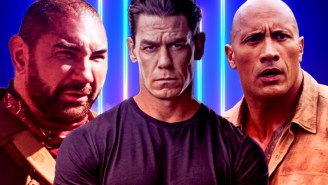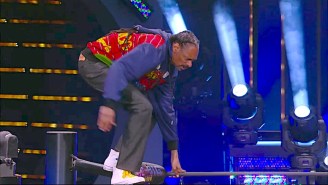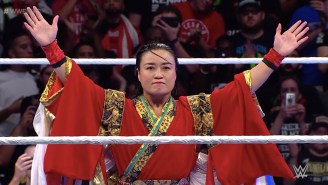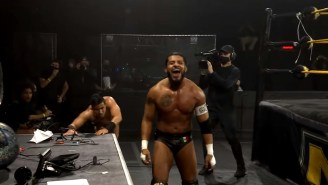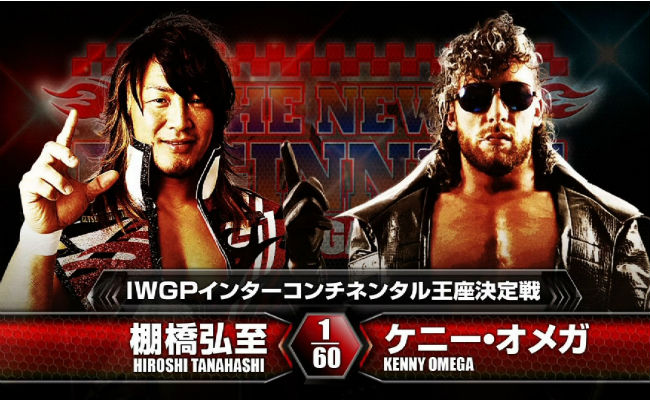
Wrestle Kingdom 13 is approaching fast, and New Japan Pro Wrestling is, of course, working to build hype for the January 4, 2019, event. On that day, the Tokyo Dome will be main-evented by G1 Climax tournament winner Hiroshi Tanahashi challenging Kenny Omega for the IWGP Heavyweight Championship. In addition to a battle for the direction of the company, this will be the second-ever singles match between these two wrestlers. For those that haven’t seen their first match before or want to revisit it, Omega vs. Tanahashi for the IWGP Intercontinental Championship from The New Beginning in Niigata on February 14, 2016, is free on NJPW World or the NJPW YouTube channel this week.
This match was a huge step for Kenny Omega’s career, and signaled a significant reshuffling of the New Japan main event scene. In February 2016, NJPW was facing the loss of some of their biggest stars. AJ Styles failed to win the IWGP Intercontinental Championship at Wrestle Kingdom 10 (in the awesome match that NJPW put up for free before another wrestling company’s biggest show of 2018) and was beaten out of the Bullet Club in an attack led by the Young Bucks and Omega. Other Biz Cliz brothers and key players in the heavyweight tag team scene, Karl Anderson and Doc Gallows, challenged for the tag titles for the final time in Niigata and would make their own, more emotional departure at Honor Rising 2016 later the same month.
More significantly, Shinsuke Nakamura had announced his departure for WWE after retaining the Intercontinental Championship at Wrestle Kingdom 10. The loss of Nakamura was huge. Not only was he extremely popular, but he was important to the company’s history. When he debuted in 2002, he impressed so much that he earned the nickname “the Super Rookie,” was dubbed one of the “new Three Musketeers” along with Tanahashi and Katsuyori Shibata, and became the youngest IWGP Heavyweight Champion ever at the age of 23. In the late 2000s, his unique King of Strong Style persona and rivalry with Tanahashi were key parts of NJPW’s evolved product. When he was essentially replaced by Okada in the scene for the Heavyweight Championship, he elevated the IC title and became its defining champion. The company gave him the above six-minute long hype/tribute video for his last match, a six-man tag on a Road to the New Beginning show.
After this match, Omega showed up to mock Nakamura and claim he was leaving because he was afraid to face him. Right before Omega had started a new era for the Bullet Club by declaring himself the group’s new leader, he had announced was moving up to heavyweight and challenged Nakamura for the title Styles had failed to win. But now Nakamura was vacating the Intercontinental Championship and Omega would have to face a mystery opponent… who revealed himself on this Road To show to be Hiroshi Tanahashi, Nakamura’s greatest rival.
In their match in Niigata, Tanahashi is his usual amazing Ace self, but also pays tribute to his best enemy with a “Come on!” taunt, his take on the Good Vibrations in the corner, and a Bomaye knee (now called the Kinshasa, a name with an additional degree of separation from Antonio Inoki, when Nakamura does it) early on. Omega references Nakamura as well, busting out the V-Trigger, his version of the Bomaye that would make him Mr. Knee Strike in NJPW and beyond, in a key moment of the match. He also calls back to a more recent enemy with a Styles Clash.
But this IC title match is also huge for Omega making his own name as a heavyweight and a main eventer. In addition to wrestling a great match, he shows the Bullet Club leader version of his Cleaner persona, directing various friends and cronies (oh hey, Cody Hall!) to attack Tanahashi’s injured shoulder during the match and busting out the broom afterward. Omega would become the first non-Japanese G1 Climax winner later that year and would make waves with his match with Okada at Wrestle Kingdom 11, securing his position in the company’s big four alongside the Rainmaker, Tanahashi, and Tetsuya Naito.


